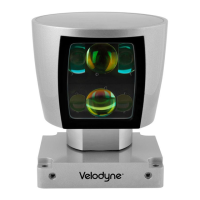High Definition LiDAR Sensor
Velodyne LiDAR, Inc.
©
2019
FocalDist(i)=FocalDist(i)—65536; end FocalDist(i)=FocalDist(i)/10;
FocalSlope(i)=temp2(5)*256+temp2(4); if FocalSlope(i)>32768
FocalSlope(i)=FocalSlope(i)—65536; end FocalSlope(i)=FocalSlope(i)/10;
% Maximum and Minimum Intensity only 1 Byte each.
MinIntensity(i)=temp2(6);
MaxIntensity(i)=temp2(7);
End % Done with correction factors.
% Get Unit Parameter Data
s=Ind(1) char(status(s—80:s+6)) value(s—80:s+6)
Version=dec2hex(value(s—1)) Temperature=value(s—2) GPS=value(s—3)
speed=single(value(s—48))+single(value(s—47))*256
Fov^start=single(value(s—46))+single(value(s—45))*256
Fov^end=single(value(s—44))+single(value(s—43))*256
warning=value(s—13)
power=value(s—12) Humidity=value(s—58)
% Done with Unit Parameters.
Calibration and Sensor Parameter Data
Laser ID # is a 1-byte integer. Most of the output calibration data are 2-byte signed integers, except
minimum and maximum intensity, which use 1 byte each. See Appendix E for more information.
Status Type
ASCII Value Interpretation
and Scaling
Vertical correction
Divide by 100 for mm
Rotational angle correction
Divide by 100 for mm
Distance far correction
mm
Distance correction X
mm
Distance correction Y
mm
Vertical offset correction
mm
Horizontal offset correction
mm
Focal distance
mm
Focal
slope
Divide by 10 to scale
Minimum intensity
No
scaling
Maximum intensity
No
scaling

